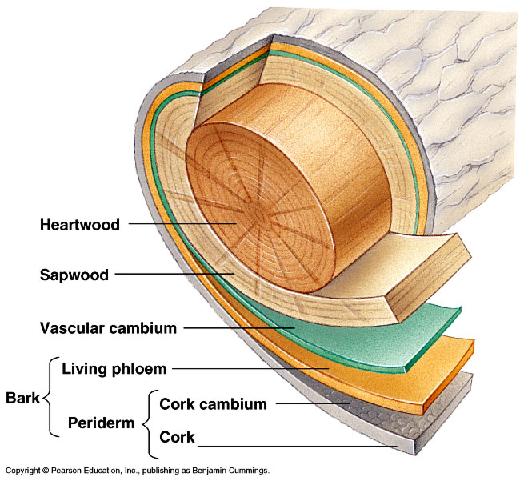 [S]
[S]
WOOD & HOLLOW TREES
by Grandpa Cliff Oct 20, 2005
SOME USES OF WOOD
1) Lumber -- its main use is in construction of buildings
2) Veneer -- on paneling, it is the very thin piece of attractive wood glued to the side which faces into a room
3) Pulp -- ground up wood that is used in newspapers, magazines, cardboard, and other paper products
[Wood pulp is usually made from softwood trees such as spruce, pine, fir, larch and hemlock, but also from
some hardwoods like birch] See another website for more information about pulp.
4) Fuel -- in a fireplace or stove
PARTS OF THE STEM OF A TREE
1) Bark - the outside layer of a tree trunk or branch.
2) Cambium - a thin layer between the sapwood and the bark; it causes the growth of a new outer ring of
sapwood to grow each year. It also adds a new layer to the inner part of the bark each year.
Its technical name is the Vascular Cambium (to distinguish it from the Cork Cambium).
3) Wood
a) Heartwood - found at the center of a trunk or large branches. It often has a dark color. Many branches,
especially the smaller ones, do not have any heartwood. The heartwood is dead wood. Wood is made of
xylem (ZIGH-lem) cells.
b) Sapwood - the live, outer part of the wood. The sap moves upward through it. Sap is mostly water and
minerals that the roots have taken out of the soil. All of the wood in small or medium-sized branches is
sapwood. As branches get thicker, the center part may become heartwood. Heartwood and sapwood are
both made of xylem (ZIGH-lem) cells.
c) Pith - located at the center of a stem during the first year of growth. It does not grow any larger after the
first year. It is not always visible in older wood. It is the light center and first dark ring of the next diagram.
 [S]
[S]
The lines that look like spokes on a wheel are Rays (Medullary Rays).
They allow water, food and minerals to go sideways in a tree trunk or branch.
__________________________________________________________________________________________
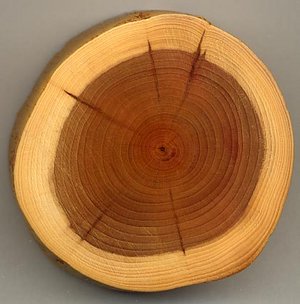
This photo shows a cross section of a Yew trunk or branch. The Yew is an
evergreen shrub that is sometimes planted near houses, so this piece of wood
is only a few inches wide. The photo shows the light sapwood, the dark
heartwood, and the pith at the very center. The dark lines could be small
branches that were enclosed in the wood as the stem got wider. They could
also be Rays. Look carefully and you will notice that each line leads out to a
slight depression in the outer surface of the wood. [S]

The heartwood and sapwood are easy to tell apart in this photo. The pith
cannot be seen. Notice that the sapwood does not have the same thickness all
the way around the stem. If it is a trunk, that would usually mean that the
trunk was leaning a bit rather than growing straight up. [S]
Science is a subject that is very exciting to me. Scientists are observant people. That mean that they notice a lot of interesting things that a lot of other people do not. Once I notice something mysterious, I ask myself what caused it to be that way. A knowledge of science allows me to solve lots of the puzzles that I find in nature. For example, while looking at the end of the log above, I wondered why there was a line through the middle of the cut end. Looking closely at the details in the photo allowed me to make the following guesses.
1) The person who cut the tree down started the first cut at about 11 o'clock and sawed a little past the middle.
2) Then the person walked around the tree and started the second cut at about 5 o'clock.
3) The two cuts did not meet perfectly so a line was made where they met.
4) When the tree fell, it twisted a little before it fell. I know this because the sapwood at 3-4 o'clock got scraped and some of the bark got ripped loose.
The cut marks on the surface of the wood would make it possible to know if the tree was cut down with a regular saw or a chain saw. I don't have enough experience with chain saws to decide.
Once you understand more about science, you will see clues like I saw on the cut end of the log. Scientists notice these kinds of things and have fun trying to figure out what happened. Your own yard contains a great many mysteries waiting to be solved. Be curious. Wonder about the things that you find in nature. Once you find something mysterious, you can take steps to solve the mystery. You can think about it, discuss it with your friends, ask adults about it, or try to find the answer at the library or on the internet. You might even do a little experiment to see if that will give you the answer.
-------------------------------------------------------------------------------------------
The sapwood of the next photo is flat at the end, so we know that the tree was cut down. I'll bet you knew that as soon as you saw the photo. The tree didn't fall down or get blown down, either of which would have left a ragged surface on the wood. The heartwood in the log is rotting and the log is starting to become hollow at the cut end. We cannot tell from the photo if the tree started rotting before or after it was cut down. [S]
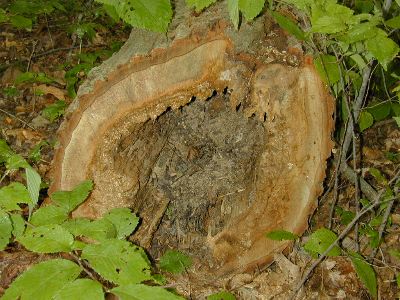
As long as a tree is healthy, the dead heartwood is very strong and it does an excellent job of helping to hold the tree up. Some trees can grow for 200 years or more without the heartwood rotting. When healthy trees are cut down, all of the wood of the trunk is solid enough that it can be cut into lumber.
DECAYING HEARTWOOD
Sometimes a large branch can fall off in the wind or because of a lightning strike. Sometimes branches are cut off by the home owner or by the electric company if the branches are getting too near the electric lines. The heartwood and sapwood of the branch is connected to the heartwood and sapwood of the trunk. Decay (rotting) can start in the exposed heartwood or sapwood where the branch fell off or was cut off. Then the decay spreads to the inside of the tree trunk, softening the heartwood as it spreads. Decaying heartwood makes a very good home for carpenter ants, termites, and other insects that burrow through the decaying heartwood.
When the heartwood gets soft enough, squirrels and tree-climbing raccoons can dig it out and use the center of the tree for a home. I have seen a tree like that with at least one raccoon living in it (at the Five Rivers Environmental Education Center near Delmar, Albany County, NY). Even if the tree trunk has a soft or partially hollow center, the tree may look normal to the property owner. Trees with weakened heartwood often suffer great damage in storms with strong winds, because their branches and trunks are not as strong as they are in healthy trees.
Notice in the rotting log above that the sapwood is not healthy at 1 o'clock on the log's cut surface. Whatever happened to the tree at that spot probably allowed the rotting to begin. As long as the bark of a tree remains healthy and covers the tree in all places, the decay can't get started.
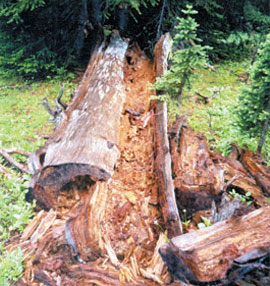
The trunk of this dead tree has been broken open allowing us to see the rotten
heartwood.
-------------------------------------------------------------------------------------------
You can see green weeds through the hole.
Although the heartwood and bark are gone, the
sapwood still can be seen in this hollow piece of a tree.

-------------------------------------------------------------------------------------------
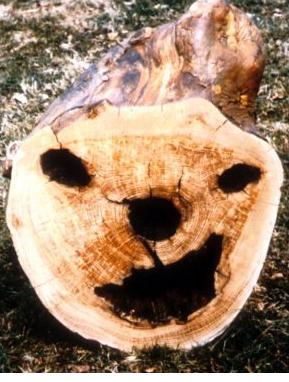 [S]
[S]
Before a log becomes completely hollow, it may form an unusual pattern. This log seems to have eyes, a nose, and a mouth, all formed in the heartwood. The sapwood is the narrow lighter area at the outside edge of the log. The nose is the center of the heartwood. The eyes may have been branches that entered the trunk at an angle, the branch wood having completely rotted away. The mouth may have been one large branch or two small branches, also entering the trunk at an angle.
-------------------------------------------------------------------------------------------
At my home, a dead branch about 9" wide got broken off in the wind. Rather than fall all of the way to the ground, it got stuck in the tree. It rested there in a horizontal position for 4-5 years before falling the rest of the way. After about two years the bark had fallen off. By the last year, the heartwood had rotted enough at the broken end so that a sparrow could pick out pieces of the soft heartwood and make a cavity for a nest inside the branch. Wildlife put their surroundings to good use. The next photo an excellent example of that.
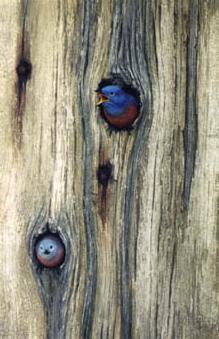
The two Western Bluebirds above are resting in knotholes in a fence post (see rusty nails). When the posts for the fence were cut, small branches emerged from the spot where the holes are now (see Knots & Knotholes). The holes formed when the base of each small branch (inside the post) decayed. The Bluebirds may have a nest in the decayed center of the post. The male is the more colorful Bluebird which is singing. [In birds, if males and females don't look alike, the male is almost always the more colorful of the two. The females usually are the ones that sit on the eggs and keep the hatched babies warm. The females usually have duller colors so that they can't be seen easily by larger birds which, if they were attracted to the nest, would eat the female, the eggs, or the baby birds.]
Squirrels also like 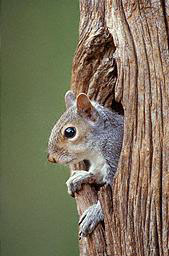 hollow trees.
hollow trees.
Long ago, a branch used to be where the hole is in this tree. [S]
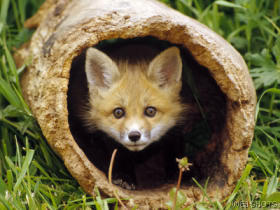
A young Red Fox [S]

Raccoon [S]
-----------------------------------------------------------------------------------------------------------
Visitors since 30 Dec 2006
Go to the HOME page